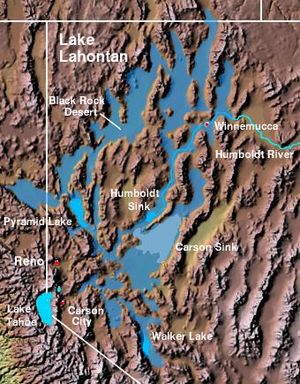Lake Lahontan facts for kids
Lake Lahontan was a huge ancient lake. It existed during the Ice Age (a time called the Pleistocene epoch). This lake was special because its water didn't flow out to the ocean. Instead, it stayed in a giant bowl-shaped area. Lake Lahontan covered much of what is now northwestern Nevada. It also reached into parts of California and Oregon. This area is part of the Great Basin.
Contents
Where Did the Name Come From?
The lake was named after a French soldier. His name was Louis-Armand de Lom d'Arce de Lahontan, Baron de Lahontan.
When Lake Lahontan Was Biggest
About 12,700 years ago, Lake Lahontan was at its largest. This was during the last big Ice Age. At that time, it was one of the biggest lakes in North America.
How Big Was It?
The lake covered more than 8,500 square miles (22,000 square kilometers). That's bigger than some states! Its deepest parts were impressive. Near what is now Pyramid Lake, it was about 900 feet (275 meters) deep. In the Black Rock Desert area, it was still around 500 feet (150 meters) deep.
How the Lake Shrank Over Time
After the Ice Age ended, the climate started to get warmer. This caused ancient Lake Lahontan to slowly dry up. By about 9,000 years ago, the huge lake had mostly disappeared.
What Happened to the Water?
As the water level dropped, the big lake broke into many smaller lakes. Most of these smaller lakes quickly dried up too. They left behind flat, dry lakebeds called playas. Famous playas today include the Black Rock Desert and the Carson Sink.
Lakes That Remain Today
Only a few parts of ancient Lake Lahontan still exist as true lakes. These are Pyramid Lake and Walker Lake. Winnemucca Lake has been dry since the 1930s. Honey Lake also dries up completely sometimes. You can still see old shorelines of the ancient lake. They are marked by special rock formations called tufa.
Why Did Lake Lahontan Dry Up?
Scientists believe the area wasn't much wetter during the Ice Age. Instead, the lake dried up mainly because the climate got warmer. This caused more water to evaporate from the lake's surface. So, the warming air "drank" the lake's water.
Could It Come Back?
Some computer studies suggest something interesting. If the climate returned to Ice Age conditions, Lake Lahontan might reappear. This would happen if there was a lot of rain and very little evaporation.
Life Around Ancient Lake Lahontan
Evidence shows that people lived near Lake Lahontan when it was huge. This was around the time humans first arrived in the region.
The Lahontan Cutthroat Trout
A special fish called the Lahontan cutthroat trout lived in Lake Lahontan. It was a predator, meaning it hunted other fish. It ate smaller fish like chub and sucker. This type of trout still lives today in rivers that once fed the ancient lake. Efforts have been made to bring them back to Pyramid Lake and Walker Lake. They had disappeared from these lakes in the 1900s.


